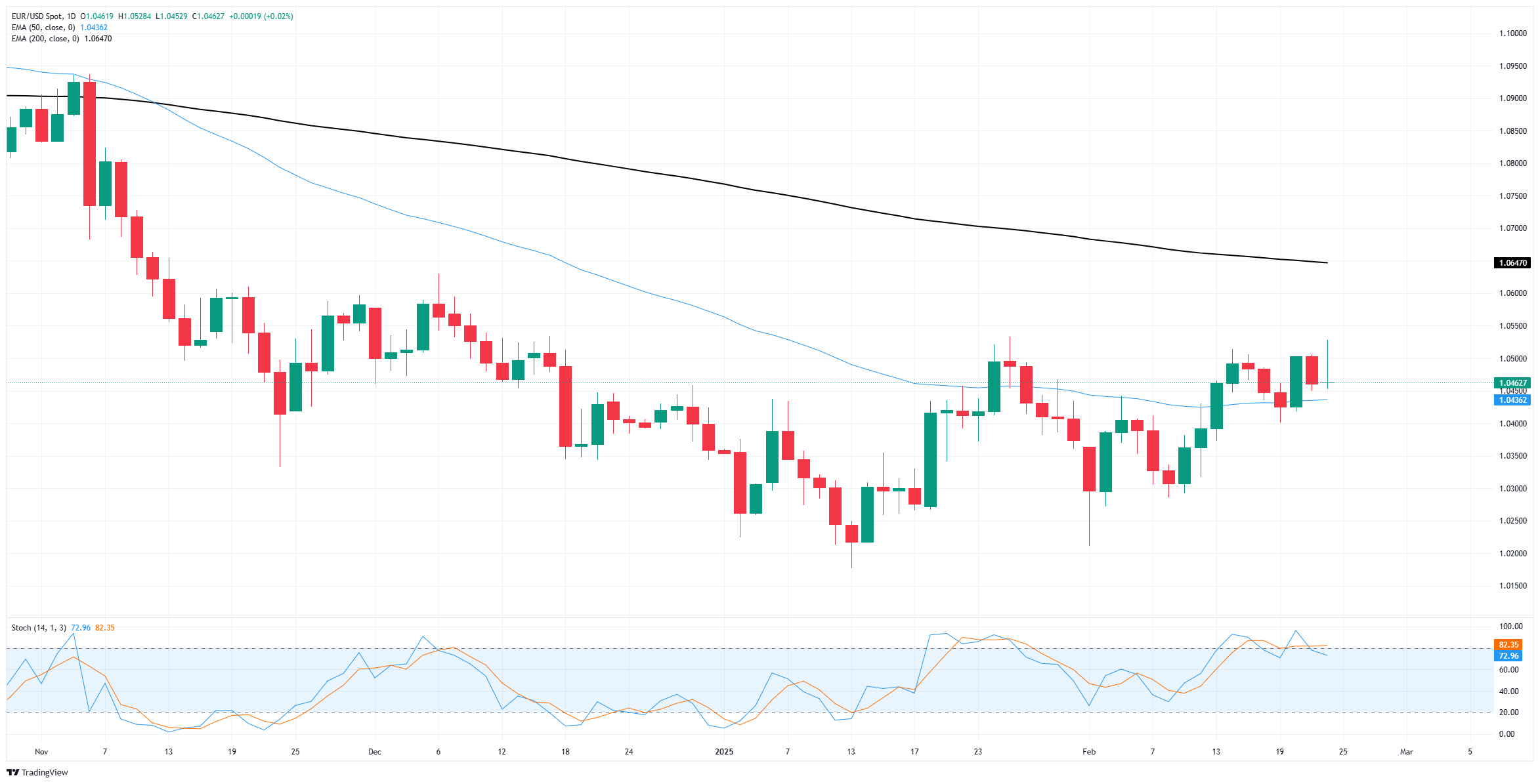EUR/USD stuck below 1.0500 to kick off the new trading week
- EUR/USD remains hunkered below 1.0500 as bulls run out of steam.
- European data is limited for most of the week, with Fed speakers set to dominate.
- German and US inflation figures will close out the week.
EUR/USD cycled familiar territory on Monday, testing the 1.0500 handle but failing to make any meaningful headway as Fiber continues to churn near the top end of recent consolidation.
Last week's rise in US inflation figures triggered a new wave of risk aversion among investors. Their attention is now squarely on the upcoming US Personal Consumption Expenditure (PCE) inflation data expected later this week. Traders are hoping that the early-year increase in headline inflation in the US will diminish swiftly and not lead to another prolonged struggle over “transitory” inflation that runs too hot for the Federal Reserve (Fed) to implement rate cuts. Market participants eager for a quicker pace of Fed rate cuts in 2025 are already feeling the pressure as US President Donald Trump attempts to ignite a global trade war. Additionally, another surge in inflation may extinguish any remaining hopes for rate reductions. On Monday, President Trump reiterated threats of high tariffs on Canada and Mexico, cautioning that tariffs are still expected to take effect “next month,” following his recent concession on tariff pressures and granting delays to nearly every country he has targeted with import taxes on his own citizens.
German Consumer Price Index (CPI) inflation is also due on Friday, as well as German Retail Sales activity figures. As a bellwether for pan-EU data, Germany’s data prints on Friday will likely draw some Fiber traders’ eyes, but the key market-moving print will still be US PCE inflation.
EUR/USD price forecast
EUR/USD continues to churn near the 50-day Exponential Moving Average (EMA) near 1.0435, with price action hobbled just south of 1.0500. Daily candles continue to close inside of a near-term rough wedge, albeit with some uninspired tests in either direction.
The pair’s last major swing low dipped below 1.0200 in mid-January, but bullish momentum remains limited with the pair still trading well below the 200-day EMA at 1.0650.
EUR/USD daily chart
Euro FAQs
The Euro is the currency for the 19 European Union countries that belong to the Eurozone. It is the second most heavily traded currency in the world behind the US Dollar. In 2022, it accounted for 31% of all foreign exchange transactions, with an average daily turnover of over $2.2 trillion a day. EUR/USD is the most heavily traded currency pair in the world, accounting for an estimated 30% off all transactions, followed by EUR/JPY (4%), EUR/GBP (3%) and EUR/AUD (2%).
The European Central Bank (ECB) in Frankfurt, Germany, is the reserve bank for the Eurozone. The ECB sets interest rates and manages monetary policy. The ECB’s primary mandate is to maintain price stability, which means either controlling inflation or stimulating growth. Its primary tool is the raising or lowering of interest rates. Relatively high interest rates – or the expectation of higher rates – will usually benefit the Euro and vice versa. The ECB Governing Council makes monetary policy decisions at meetings held eight times a year. Decisions are made by heads of the Eurozone national banks and six permanent members, including the President of the ECB, Christine Lagarde.
Eurozone inflation data, measured by the Harmonized Index of Consumer Prices (HICP), is an important econometric for the Euro. If inflation rises more than expected, especially if above the ECB’s 2% target, it obliges the ECB to raise interest rates to bring it back under control. Relatively high interest rates compared to its counterparts will usually benefit the Euro, as it makes the region more attractive as a place for global investors to park their money.
Data releases gauge the health of the economy and can impact on the Euro. Indicators such as GDP, Manufacturing and Services PMIs, employment, and consumer sentiment surveys can all influence the direction of the single currency. A strong economy is good for the Euro. Not only does it attract more foreign investment but it may encourage the ECB to put up interest rates, which will directly strengthen the Euro. Otherwise, if economic data is weak, the Euro is likely to fall. Economic data for the four largest economies in the euro area (Germany, France, Italy and Spain) are especially significant, as they account for 75% of the Eurozone’s economy.
Another significant data release for the Euro is the Trade Balance. This indicator measures the difference between what a country earns from its exports and what it spends on imports over a given period. If a country produces highly sought after exports then its currency will gain in value purely from the extra demand created from foreign buyers seeking to purchase these goods. Therefore, a positive net Trade Balance strengthens a currency and vice versa for a negative balance.


